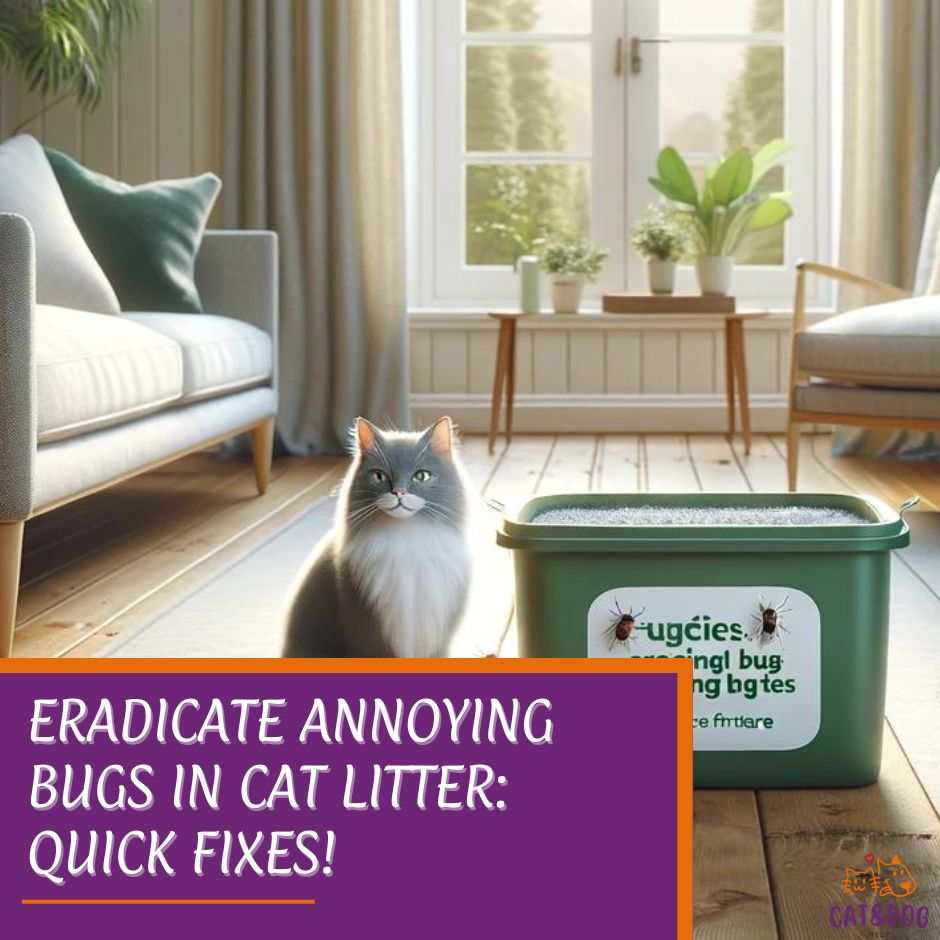Maintaining a pristine litter box is more than a matter of cleanliness; it’s a battleground for preventing an uninvited assembly of bugs that can invade your cat’s personal space.
You might wonder, how these tiny intruders find their way into such a well-kept area, right? From fungus gnats to the occasional ant, these pests can cause a headache for any cat owner.
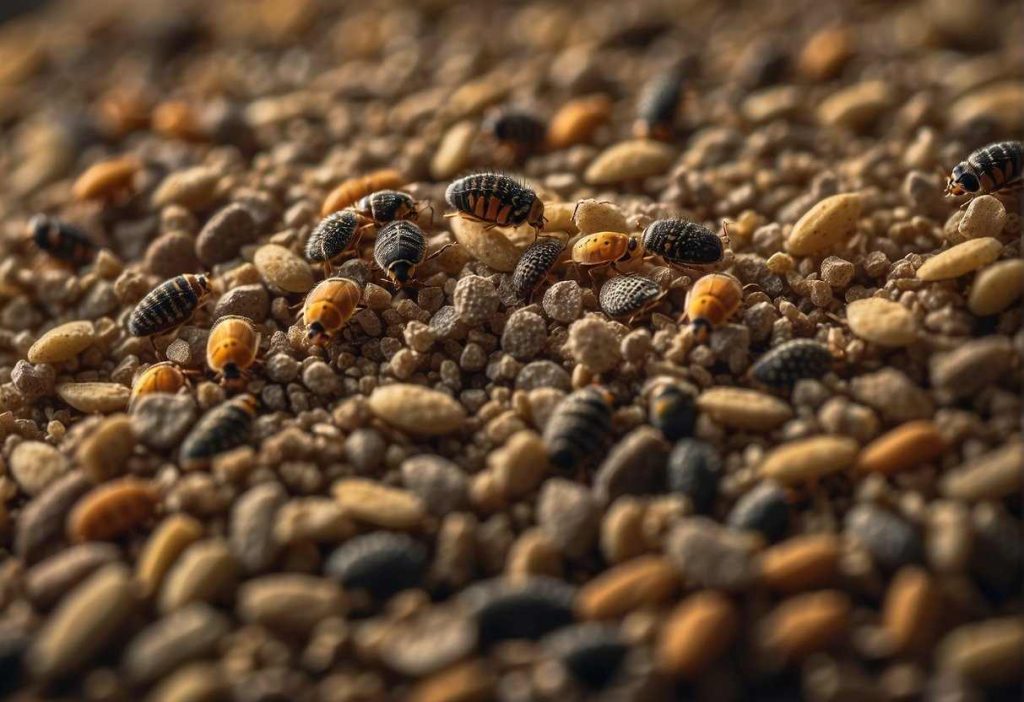
But why should you care? Well, uninvited guests in your cat’s litter box aren’t just a nuisance; they can signal a problem that affects the health of both you and your furry friend.
Identifying what bugs have made a home in the litter, understanding why they’re there, and knowing how to safely leave them an eviction notice are key to maintaining a happy, healthy home.
Now that we’ve scratched the surface, let’s dive into the nitty-gritty of keeping these pests at bay. I’ll guide you through some awesomely effective strategies that are simpler than herding cats!
So, are you ready to reclaim your cat’s throne from these buggy usurpers?
Key Takeaways
- A clean litter box is essential to prevent bugs and maintain cat health.
- Identifying specific bugs is the first step to addressing infestations.
- Safe elimination and prevention methods protect both cats and humans.
Identifying Common Bugs in Cat Litter
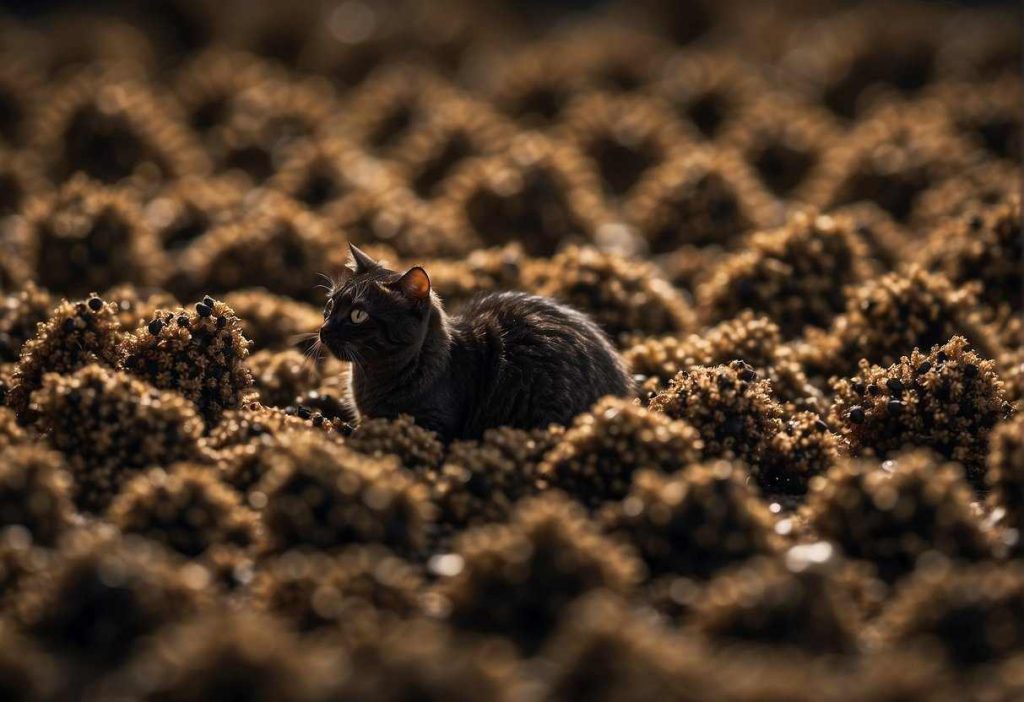
Fleas: These tiny jumping insects are notorious for their itchy bites. They’re about 1/8 inch long, and dark brown, and you might spot them hopping in or around the litter box. (1)
Fleas go through four life stages: egg, larva, pupa, and adult. Keep an eye out for flea dirt—looks like black pepper—which is actually their feces.
- Signs: Itchy cat, tiny black droppings, or small brown bugs leaping about.
Ants: Uninvited to the kitty party, ants are attracted to the feast of organic matter in the litter. They come in various sizes but typically measure around 1/16 to 1 inch. Ants are your tidy-up crew gone rogue. (2)
- Signs: A trail of tiny soldiers marching towards the litter box.
Cockroaches: These guys are the tough cookies of the insect world, preferring warm, moist environments. Some roaches can get quite large, up to a couple of inches! (3)
- Signs: Spotting them at night or finding their oval-shaped droppings.
Gnats: These small, dark, flying nuisances find dampness utterly enjoyable. Gnats are attracted to moisture and will buzz around a litter box that’s overdue for a clean. (4)
- Signs: Swarm of tiny flying insects circling the litter box territory.
Beetles: These insects might crash the litter box looking for organic materials to nibble on. They have hard shells and can vary greatly in size.
- Signs: Beetles are pretty chill, so you’ll often find them just hanging around the box.
In addition to regular cleaning and bug prevention measures, implementing effective litter odor control strategies can significantly reduce the attraction of pests to your cat’s litter box, keeping it fresher and more inviting for your furry friend
Curiosity didn’t just get the cat; it got you looking closer at creepy crawlies. Remember, a clean box is a less bug-friendly box. If you do discover bugs, identifying them is the first step to bidding them farewell!
Health Implications of Bugs in Cat Litter
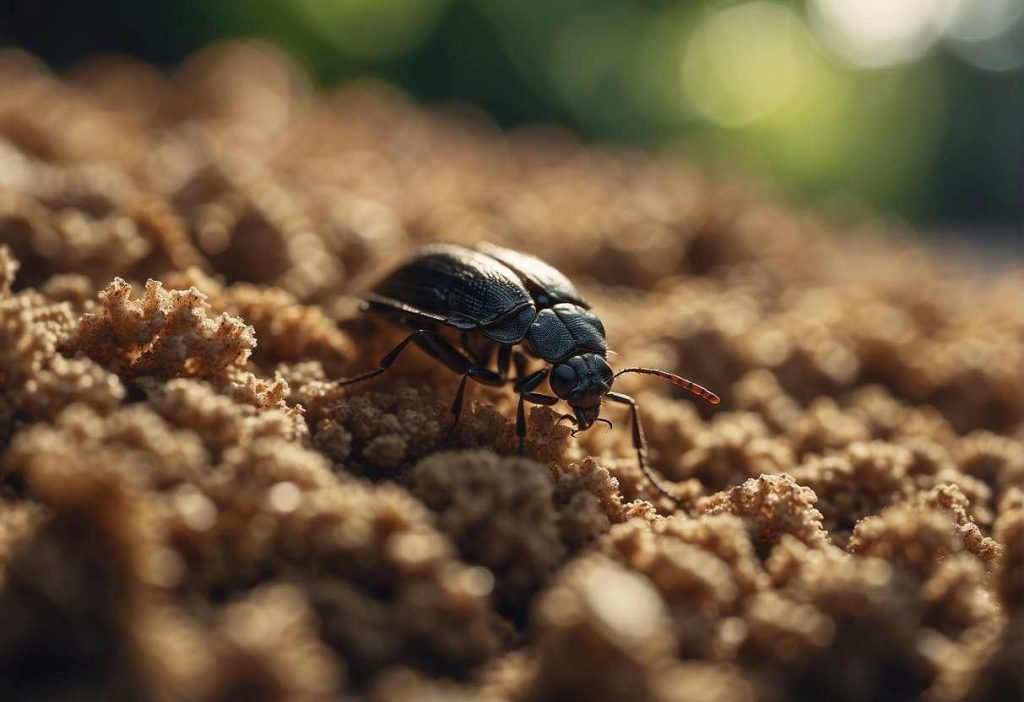
In the hidden corners of a litter box, cockroaches may thrive, exposing both you and your kitty to pathogens such as salmonella and E.coli.
These unwelcome critters are capable of causing food poisoning and various illnesses. If you ever spot these creepy crawlies, don’t panic but do pay attention!
Now let’s talk about flies. These buzzing invaders are notorious for laying eggs in cat feces, which can lead to parasitic infections if the larvae hatch. It might make you squirm, but it’s a real potential health hazard.
Here’s a quick checklist of signs that bugs might be impacting your cat’s health:
- Unexplained weight loss
- Diarrhea or vomiting
- Visible worms in feces or around the anus
- Constant scratching or skin irritation
For your well-being and your cat’s, it’s good practice to clean the litter box regularly and watch for any unusual signs. If something seems off—like tapeworm segments near your cat’s tail—it’s vet time!
Preventive Measures:
- Cleanliness: Keep the litter box spotless. Frequent scooping and periodic washing reduce the risk of infestation.
- Secure Trash: Ensure garbage is sealed; it’s a buffet for pests!
- Professional Advice: If you’re dealing with persistent bugs, seek expert help—better safe than sorry!
Remember, a clean litter box is a safe haven.
By staying vigilant and maintaining hygienic practices, you’re not just keeping the bugs away but also protecting the health and happiness of your furry boss and your home!
Bugs in Cat Litter: Step-by-Step Elimination Methods

Identify the Culprit: First, let’s find out who we’re dealing with. Common litter box trespassers include fungus gnats, phorid flies, maggots, and fruit flies. Grab your magnifying glass and play detective!
- Clean Sweep: Start fresh by thoroughly cleaning the litter box. Empty it out and give it a good scrub with hot, soapy water.
- Diatomaceous Earth (DE): A natural marvel, food-grade DE is a non-toxic powder that can be sprinkled in and around the litter box. It safely dehydrates the bugs upon contact. (5)
- Barrier Methods:
- Insecticide Strips: Place these near the box to gradually eliminate flying pests. Ensure they’re pet-safe!
- Sticky Traps: Around the perimeter, these can catch flies without using harsh chemicals.
- Insect-Repelling Plants: Bet you didn’t know that some greenery could help! Plants like lavender and lemon balm can deter bugs and freshen up the space. (6)
- Maintain Cleanliness: Regularly change the litter and wipe down the area. This routine maintenance is your best defense.
- Natural Sprays: A bit of DIY mixology can go a long way. Combine water and essential oils like eucalyptus or peppermint in a spray bottle and mist around the area—bugs hate these scents! (7)
- Commercial Solutions: If DIY isn’t cutting it, look for pet-friendly insecticide sprays. They should be explicitly safe for use around pets.
- Vigilance: Once you’ve treated the issue, keep an eye on the litter box. Bugs can be persistent, but so are you!
Remember, while we want to protect our fur babies, it’s important to ensure all methods are safe for them and us. So here’s to no more bugs, just purrs and cuddles!
Comprehensive Prevention Strategies
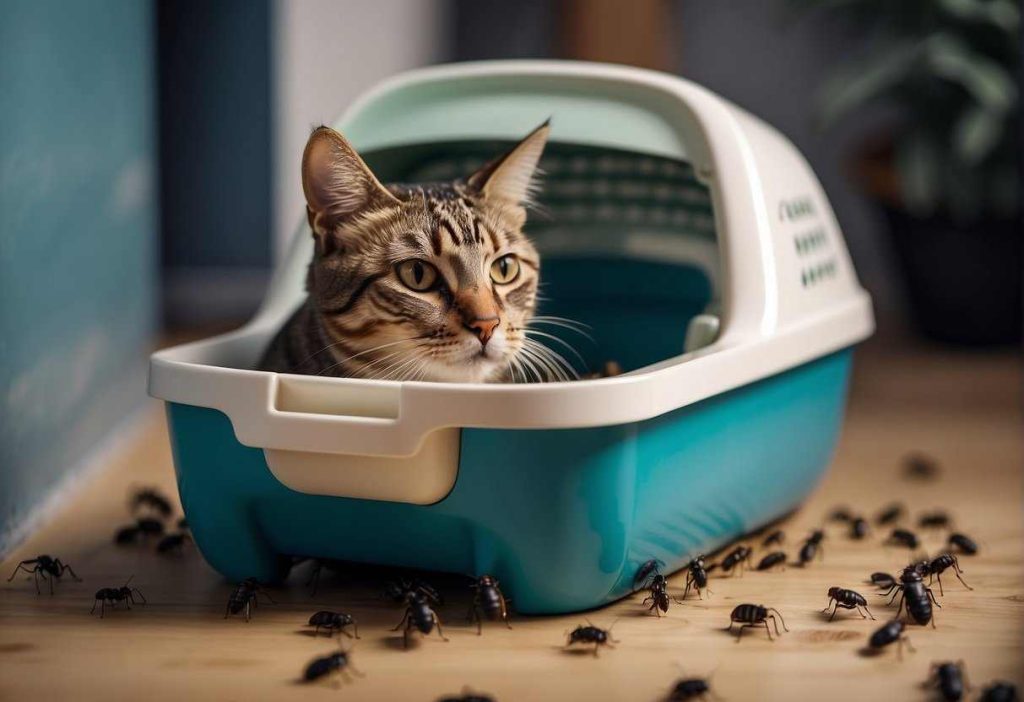
Choosing the right litter matters; some types are insect repellents by nature.
Ever tried those litters with natural oils? Bugs are not fans!
Keep it dry, folks! Moisture equals bug magnet. Reduce humidity around the litter area with:
- Dehumidifiers
- Proper ventilation
Remember, bugs love a good feast! Securing your cat’s food and keeping it separate from the litter zone works wonders. A simple, yet effective tip is to:
- Store cat food in airtight containers
Consider litter box placement carefully. A quiet corner is cozy for your cat but convenient for pests too. Here’s what you can do:
- Place litter boxes away from walls and damp areas
By following these tips, you’re building a fortress against those pesky intruders. Keep up the good work, and enjoy the pest-free bliss!
Understanding the Causes of Infestations
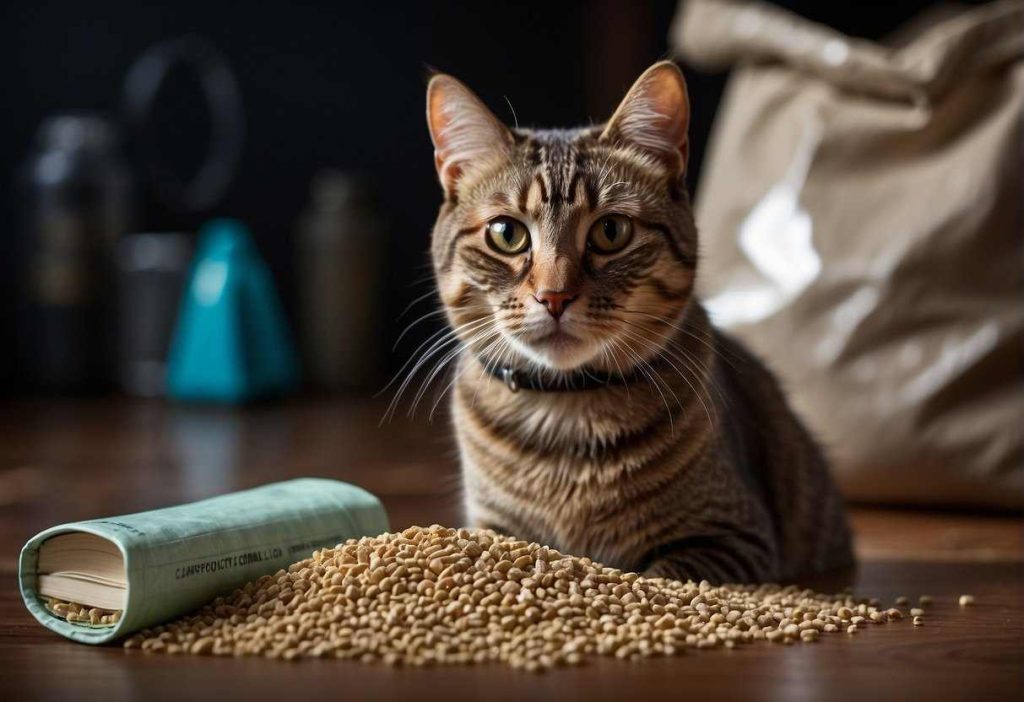
First off, cleanliness is next to pestlessness! Bugs thrive in dirty environments, and a litter box that isn’t scooped regularly is like a five-star hotel for insects. It’s essential to:
- Scoop the litter box daily
- Change the litter entirely and wash the box every 1-2 weeks
Now, you might be thinking, “But I do clean regularly!” Then, consider this: the type of litter.
Some litters are more appealing to insects because they’re like the buffet line for pests; they provide both a cozy nesting place and a snack.
Clumping and natural litter can be particularly attractive. The best practice is to:
- Test out less attractive litter alternatives such as silica gel or recycled paper
Let’s talk about the environment. Your litter box’s location can be an open invitation to bugs. Warmth, darkness, and humidity are the ultimate party zone for bugs like:
- Fleas that are looking for a warm-blooded host
- Fungus gnats craving that moist litter
You can counter this by:
- Keeping the litter box in a well-ventilated, dry area
- Using a litter dehumidifier or placing a desiccant nearby
Remember, your furry friend’s health is paramount, and keeping bugs out of the litter box is a big part of that.
A bit of vigilance and tweaking may be all it takes to keep those pesky bugs from setting up camp where they don’t belong!
Expert Contributions and Safety Considerations
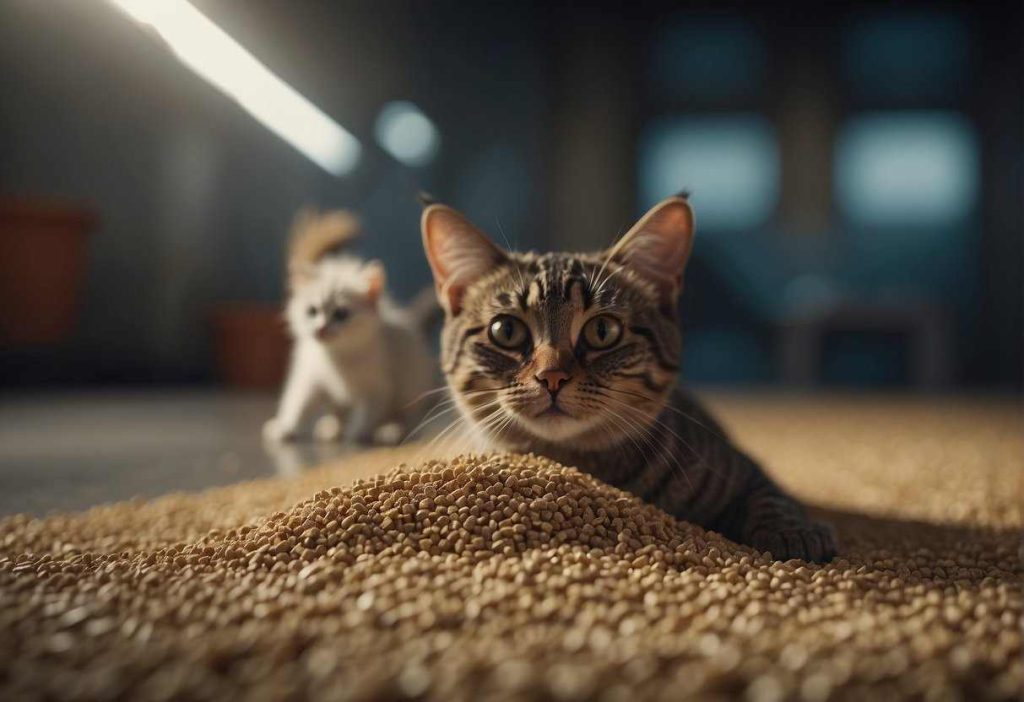
From the Vet’s Desk:
- Non-toxic Treatments: Vets stress the importance of using pet-safe pest control. You wouldn’t want your pal to ingest something harmful, would you?
- Routine Checks: Keep an eye on the litter box. Regular inspections can prevent an infestation before it picks up speed—like a cat on the hunt!
Pest Control Professionals:
- Identification: Know what you’re dealing with—fungus gnats, for example, are common but harmless. More serious bugs may require a pro.
- Preventive Strategies: Experts suggest moisture control and cleanliness to keep those creepy crawlies at bay.
Safe Pest Control Products:
- Diatomaceous earth: A non-toxic powder that dehydrates insects. Pawsome for the environment and your kitty!
- Chemical treatments: Look for those labeled ‘pet-friendly’. Safety first—always read the label!
You’ve Got This:
- Keep it dry: Bugs love moisture. Keep the litter dry and change it regularly.
- Keep it clean: Scoop daily, and you’ll likely keep the bugs away.
Remember, you’re the hero in your cat’s story—by staying informed and choosing the right products, you can ensure a safe and comfy litter box experience for your whiskered companion.
Stay curious, stay diligent, and both you and your cat will sleep (and potty) better at night!
Practical and Accessible Solutions for Cat Owners

Prevention Is Key
- Stay Clean: Make it a habit to scoop the litter box daily. A clean box is less appealing to bugs.
- Litter Quality: Opt for non-toxic, absorbent litter that clumps well and reduces moisture—an insect’s favorite hangout.
- Seal the Deal: Check that your litter box doesn’t have any cracks for pests to sneak through. A good sealing lid can help.
Easy Elimination Tactics
Worried about those pesky bugs? Here are some DIY strategies to send them packing:
- Flea Comb: Regularly groom your cat with a flea comb to catch any freeloaders.
- Insecticide Use: Apply pet-safe insecticide spray around the litter box area, but ensure it’s feline-friendly.
- Washing Routine: Launder your cat’s bedding and any bug-friendly fabrics often.
Remember: If you’ve got an infestation on your hands, it may be time to call in the pros for pest control. They’ve got the gear to deal with the nasties that refuse to budge.
Lastly, got a chuckle-worthy bug story related to your cat’s litter adventures? Share it with the community—after all, laughter is the best medicine… next to a clean litter box, of course!
Keep up the good work, and your cat’s tiny kingdom will be bug-free in no time.
Long-Term Maintenance and Monitoring
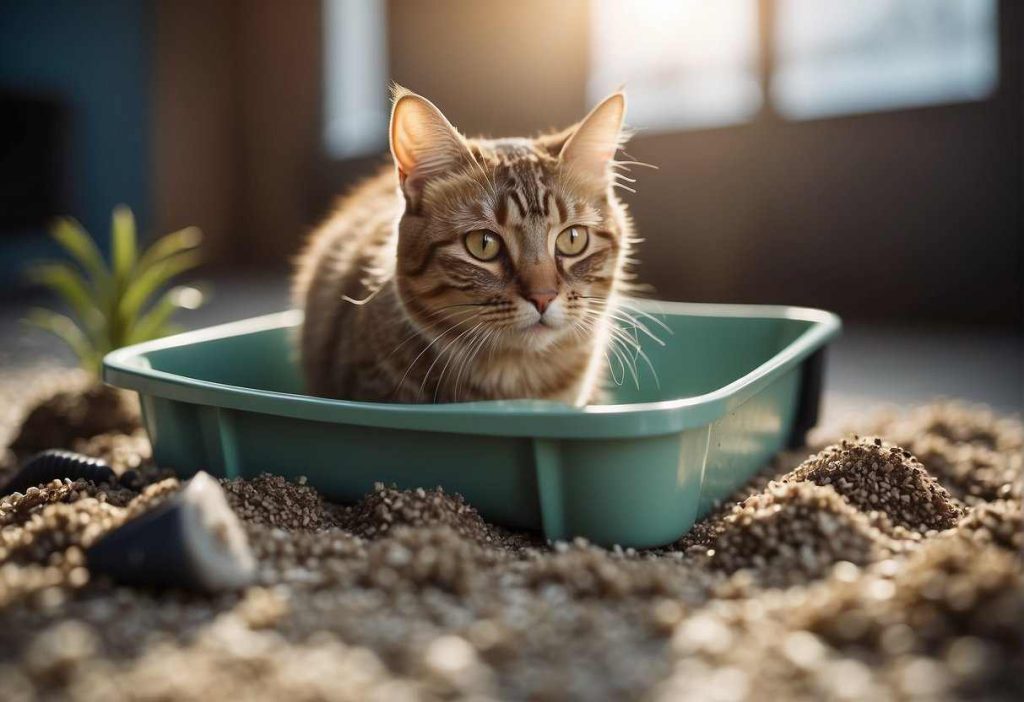
Creepy crawlies in kitty’s domain can be more than just a nuisance; they can indicate hygiene issues that might need your attention.
No need to fret! With some smart strategies and regular upkeep, you can create a fortress that bugs just won’t want to infiltrate.
Innovative Litter Solutions:
Let’s kick things off with the litter box itself. Have you seen those automatic, self-cleaning litter boxes? They might sound like a gadget out of a spy movie, but they’re real, and they can be a great ally in your quest.
- Self-cleaning Boxes:
- Regularly removes waste
- Minimizes odor and attraction to bugs
Feeding Practices:
What about your furry pal’s chow time? Believe it or not, how and where you feed your cat can influence the bug battle.
- Sealed Storage: Keep food in sealable containers to avoid attracting insects.
- Clean Bowls: Regularly wash your cat’s food and water dishes to eliminate residue.
Home Cleanliness:
Your home’s overall cleanliness plays a vital role too. A tidy abode is less inviting to bugs.
- Vacuum Often: Especially around the litter box and feeding areas.
- Empty the Trash: Dispose of litter waste in sealed bags and don’t let it sit in the bin for long.
Routine Health Check-ups: Just like you have your yearly check-up, your cat needs regular vet visits too. It’s not just to keep an eye on their health; it’s also to ensure they’re not unwittingly hosting a flea circus.
Remember:
- Annual Vet Visits
- Parasite Prevention: Ask your vet about flea and tick prevention methods.
Lastly, a bit of humor goes a long way. Imagine explaining to your cat why their bathroom needs an upgrade. “Mittens, it’s not you… it’s the ants.”
Keep an eye on your furry friend’s litter box, their health, and your home’s cleanliness, and you’ll be on the right track to a bug-free environment!
Quick Recap
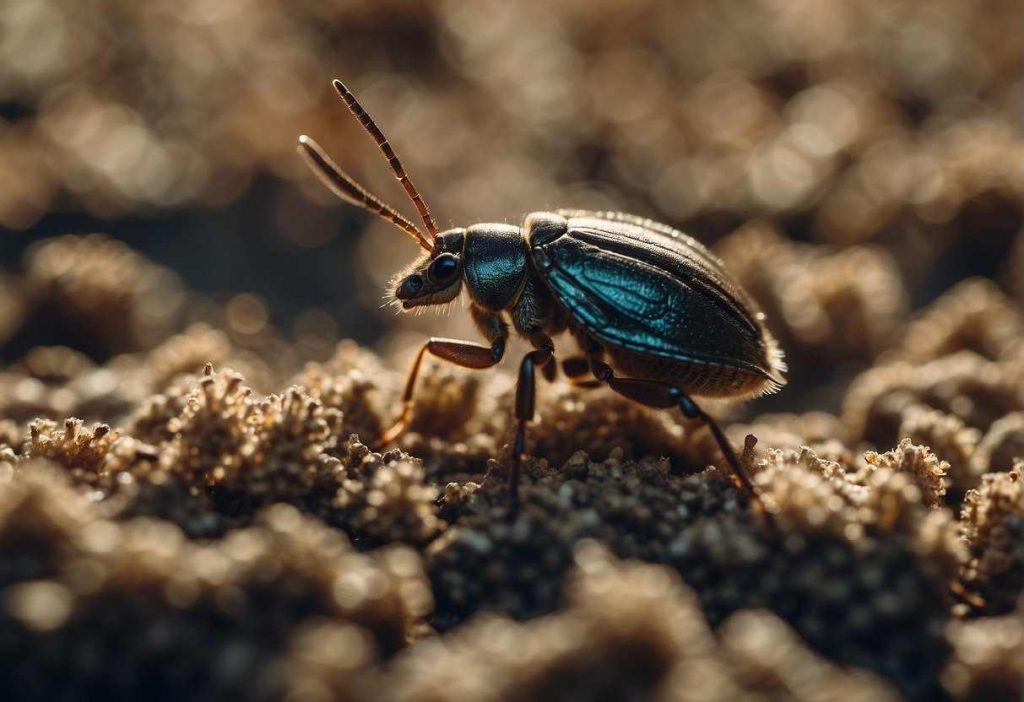
Have you noticed uninvited guests in your cat’s litter box? Here’s a quick checklist to tackle those pesky bugs:
- Identification: Know your enemy! Common litter box critters include mites, fleas, and cockroaches. Fleas are notorious for spreading diseases, while mites prefer damp environments. Cockroaches can survive in various conditions but dislike clean, frequently changed litter boxes.
- Prevention: Keep it clean! Ensure that your cat’s litter box is regularly cleaned to deter insects. A hygienic environment is key to prevention.
- Environmental Control: Don’t roll out the red carpet! Use non-toxic methods like citronella to keep bugs at bay. Position insecticide strips or spray insecticides (carefully!) around the litter box area to address existing problems.
- Professional Help: Are the bugs proving to be tenacious? Don’t hesitate to reach out to a vet or a pest control expert, especially if the infestation seems severe.
Here’s to maintaining a bug-free zone for your feline friend! Remember, consistency is your ally. With the right strategies in play, your cat’s litter box can stay a bug-free sanctuary.
Keep up the good work, and trust in the effectiveness of the methods you’ve adopted.
Frequently Asked Questions
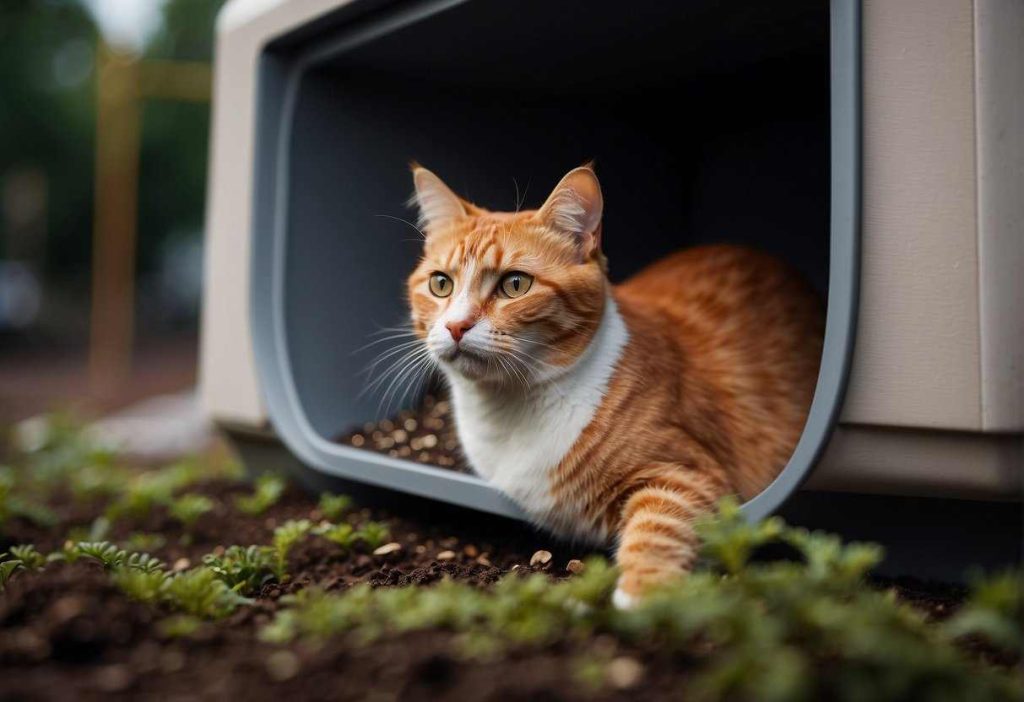
Discover the most commonly asked questions about bugs in cat litter to keep your furry friend’s space clean and safe.
What are the most common types of bugs found in cat litter?
Fungus gnats, cockroaches, and various species of flies are often unwelcome visitors in your cat’s litter box.
These pests are attracted to the moist and nutrient-rich environment that the litter provides.
How can I safely eliminate bugs from my cat’s litter box?
To safely get rid of bugs, consider natural repellents like essential oils or use an electronic repellent.
You can also try non-toxic insecticide strips placed near the litter box, but ensure they’re out of reach to avoid any risk to your cat.
Are there any health risks to my cat from bugs in the litter box?
Yes, bugs can pose health risks to your cat.
They may carry bacteria and parasites which could lead to infections, especially if your cat has open wounds or a compromised immune system.
What preventive measures can I take to keep bugs out of the litter box?
Preventive measures include:
1. Keeping the litter box clean and dry.
2. Using covered litter boxes to deter flies.
3. Placing citronella candles near the litter area as a natural deterrent.
Remember that cleanliness is key to prevention.
Can certain types of cat litter attract more bugs?
Some types of litter, especially those with organic materials like plant-based or paper litter, may attract more bugs due to their moisture-absorbing properties and potential for decomposition.
Clay-based litters are usually less attractive to insects.
How often should I clean the litter box to prevent bug infestations?
Regular cleaning is vital. Scoop the litter box daily, completely change the litter, and sanitize the box at least once a week to minimize the risk of attracting bugs.
Why is my cat avoiding the litter box, and could it be related to bugs?
If your cat is avoiding the litter box, it could indeed be due to bugs. Cats are clean animals and might be put off by the presence of pests in their space.
Ensure the litter box is bug-free and inviting to solve this problem.
- Free Online Casino Games: What You Need to Know - July 26, 2025
- Ideal Casinos Mobile: The Ultimate Guide to Mobile Betting - July 26, 2025
- The Ultimate Overview to Casino Site Gamings Online - July 26, 2025

